Detailed Report on the MLXIPL Gene and its Functions
VerifiedAdded on 2023/06/08
|9
|1612
|489
Report
AI Summary
This report provides a detailed analysis of the MLXIPL gene, a key focus in genetics and its relation to Williams-Beuren syndrome (WBS). The introduction defines genetics and introduces the MLXIPL gene, highlighting its role as a transcription factor. The main body explores the gene's overview, its association with WBS, and the impact of MLXIPL mutations. It also describes the cellular location of the gene and provides protein details including amino acid sequences and molecular mass. Furthermore, the report incorporates mouse studies (orthologs) to provide a broader understanding of the gene's function. The conclusion summarizes the key findings and emphasizes the importance of MLXIPL in genetic research. References to relevant books and journals are included to support the findings.

Genetics
Paraphrase This Document
Need a fresh take? Get an instant paraphrase of this document with our AI Paraphraser
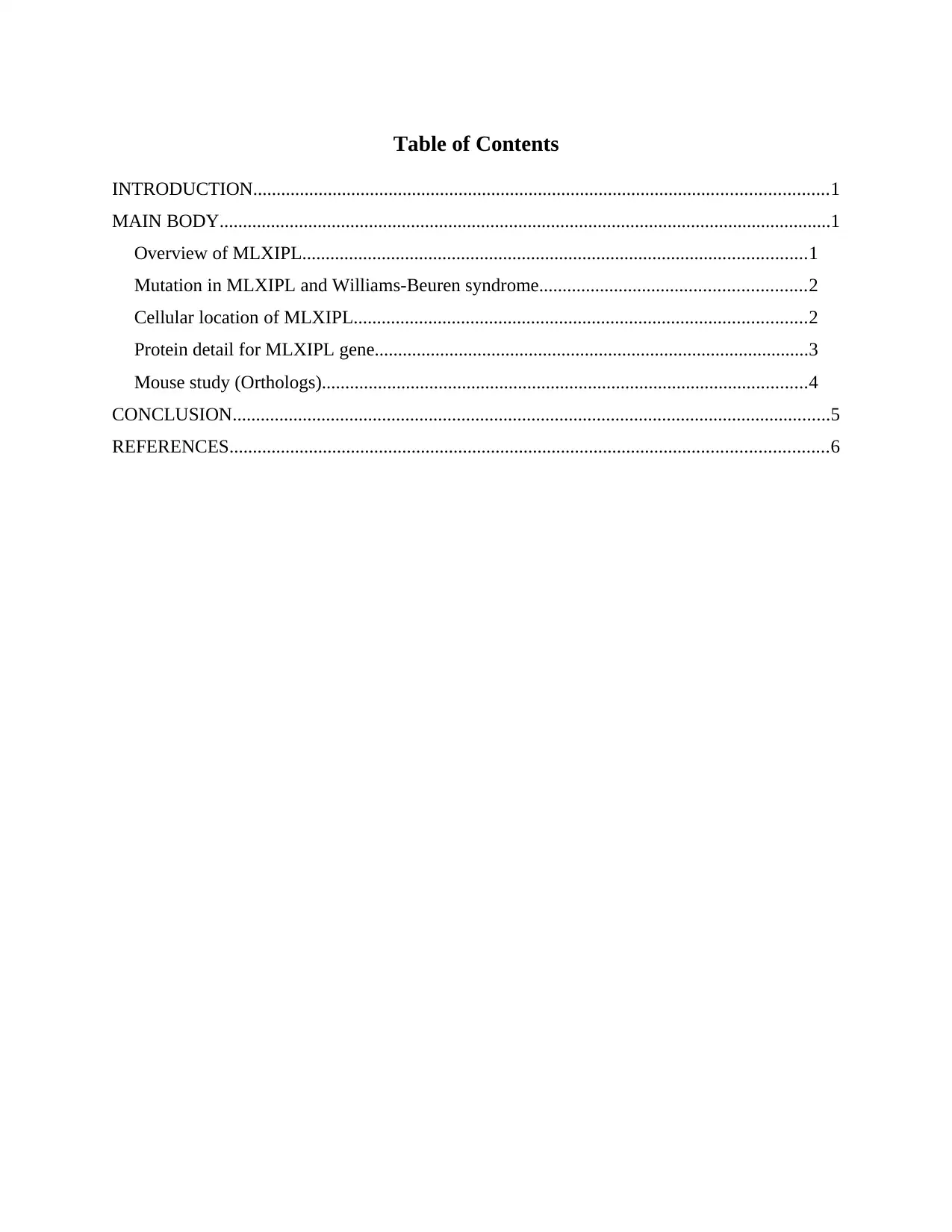
Table of Contents
INTRODUCTION...........................................................................................................................1
MAIN BODY...................................................................................................................................1
Overview of MLXIPL............................................................................................................1
Mutation in MLXIPL and Williams-Beuren syndrome.........................................................2
Cellular location of MLXIPL.................................................................................................2
Protein detail for MLXIPL gene.............................................................................................3
Mouse study (Orthologs)........................................................................................................4
CONCLUSION................................................................................................................................5
REFERENCES................................................................................................................................6
INTRODUCTION...........................................................................................................................1
MAIN BODY...................................................................................................................................1
Overview of MLXIPL............................................................................................................1
Mutation in MLXIPL and Williams-Beuren syndrome.........................................................2
Cellular location of MLXIPL.................................................................................................2
Protein detail for MLXIPL gene.............................................................................................3
Mouse study (Orthologs)........................................................................................................4
CONCLUSION................................................................................................................................5
REFERENCES................................................................................................................................6
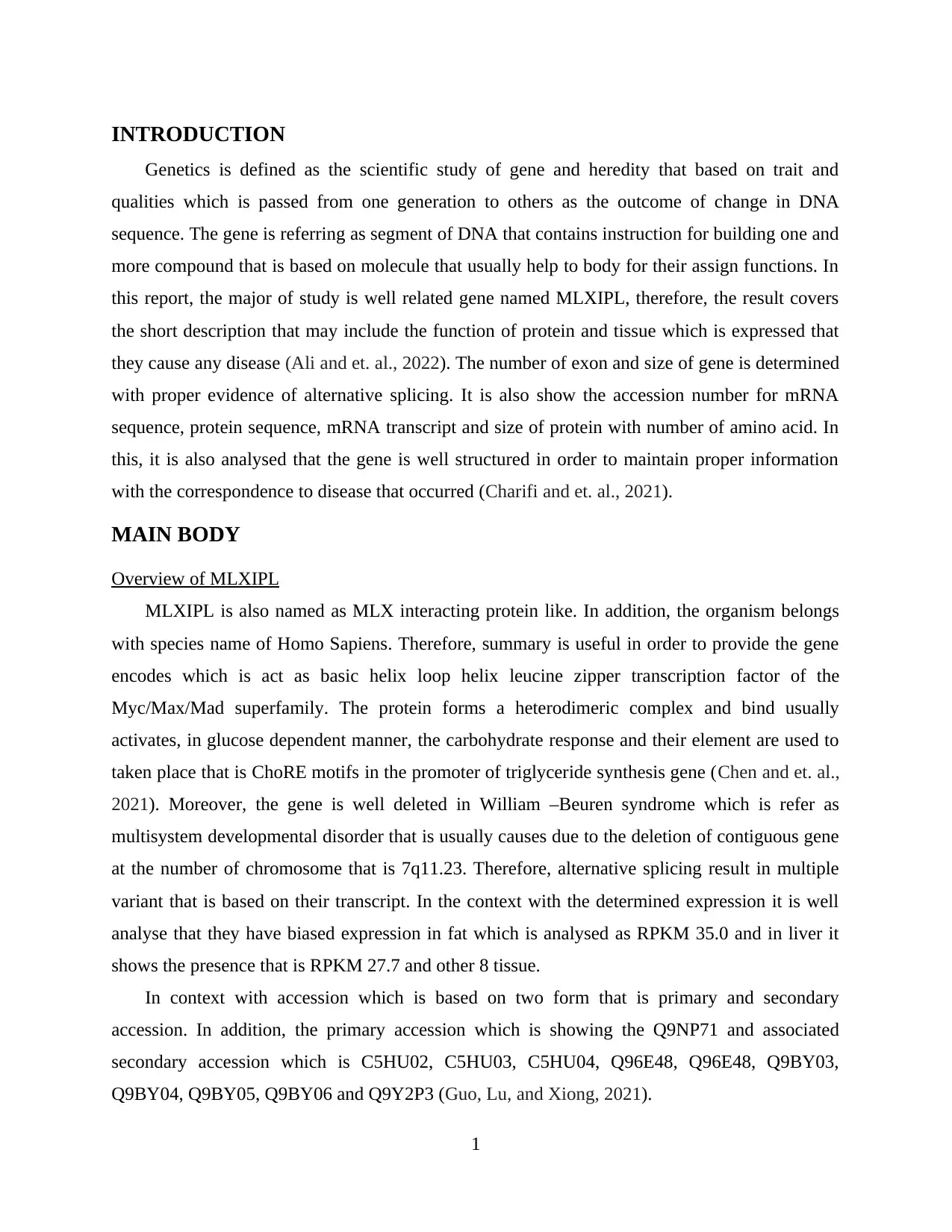
INTRODUCTION
Genetics is defined as the scientific study of gene and heredity that based on trait and
qualities which is passed from one generation to others as the outcome of change in DNA
sequence. The gene is referring as segment of DNA that contains instruction for building one and
more compound that is based on molecule that usually help to body for their assign functions. In
this report, the major of study is well related gene named MLXIPL, therefore, the result covers
the short description that may include the function of protein and tissue which is expressed that
they cause any disease (Ali and et. al., 2022). The number of exon and size of gene is determined
with proper evidence of alternative splicing. It is also show the accession number for mRNA
sequence, protein sequence, mRNA transcript and size of protein with number of amino acid. In
this, it is also analysed that the gene is well structured in order to maintain proper information
with the correspondence to disease that occurred (Charifi and et. al., 2021).
MAIN BODY
Overview of MLXIPL
MLXIPL is also named as MLX interacting protein like. In addition, the organism belongs
with species name of Homo Sapiens. Therefore, summary is useful in order to provide the gene
encodes which is act as basic helix loop helix leucine zipper transcription factor of the
Myc/Max/Mad superfamily. The protein forms a heterodimeric complex and bind usually
activates, in glucose dependent manner, the carbohydrate response and their element are used to
taken place that is ChoRE motifs in the promoter of triglyceride synthesis gene (Chen and et. al.,
2021). Moreover, the gene is well deleted in William –Beuren syndrome which is refer as
multisystem developmental disorder that is usually causes due to the deletion of contiguous gene
at the number of chromosome that is 7q11.23. Therefore, alternative splicing result in multiple
variant that is based on their transcript. In the context with the determined expression it is well
analyse that they have biased expression in fat which is analysed as RPKM 35.0 and in liver it
shows the presence that is RPKM 27.7 and other 8 tissue.
In context with accession which is based on two form that is primary and secondary
accession. In addition, the primary accession which is showing the Q9NP71 and associated
secondary accession which is C5HU02, C5HU03, C5HU04, Q96E48, Q96E48, Q9BY03,
Q9BY04, Q9BY05, Q9BY06 and Q9Y2P3 (Guo, Lu, and Xiong, 2021).
1
Genetics is defined as the scientific study of gene and heredity that based on trait and
qualities which is passed from one generation to others as the outcome of change in DNA
sequence. The gene is referring as segment of DNA that contains instruction for building one and
more compound that is based on molecule that usually help to body for their assign functions. In
this report, the major of study is well related gene named MLXIPL, therefore, the result covers
the short description that may include the function of protein and tissue which is expressed that
they cause any disease (Ali and et. al., 2022). The number of exon and size of gene is determined
with proper evidence of alternative splicing. It is also show the accession number for mRNA
sequence, protein sequence, mRNA transcript and size of protein with number of amino acid. In
this, it is also analysed that the gene is well structured in order to maintain proper information
with the correspondence to disease that occurred (Charifi and et. al., 2021).
MAIN BODY
Overview of MLXIPL
MLXIPL is also named as MLX interacting protein like. In addition, the organism belongs
with species name of Homo Sapiens. Therefore, summary is useful in order to provide the gene
encodes which is act as basic helix loop helix leucine zipper transcription factor of the
Myc/Max/Mad superfamily. The protein forms a heterodimeric complex and bind usually
activates, in glucose dependent manner, the carbohydrate response and their element are used to
taken place that is ChoRE motifs in the promoter of triglyceride synthesis gene (Chen and et. al.,
2021). Moreover, the gene is well deleted in William –Beuren syndrome which is refer as
multisystem developmental disorder that is usually causes due to the deletion of contiguous gene
at the number of chromosome that is 7q11.23. Therefore, alternative splicing result in multiple
variant that is based on their transcript. In the context with the determined expression it is well
analyse that they have biased expression in fat which is analysed as RPKM 35.0 and in liver it
shows the presence that is RPKM 27.7 and other 8 tissue.
In context with accession which is based on two form that is primary and secondary
accession. In addition, the primary accession which is showing the Q9NP71 and associated
secondary accession which is C5HU02, C5HU03, C5HU04, Q96E48, Q96E48, Q9BY03,
Q9BY04, Q9BY05, Q9BY06 and Q9Y2P3 (Guo, Lu, and Xiong, 2021).
1
⊘ This is a preview!⊘
Do you want full access?
Subscribe today to unlock all pages.

Trusted by 1+ million students worldwide
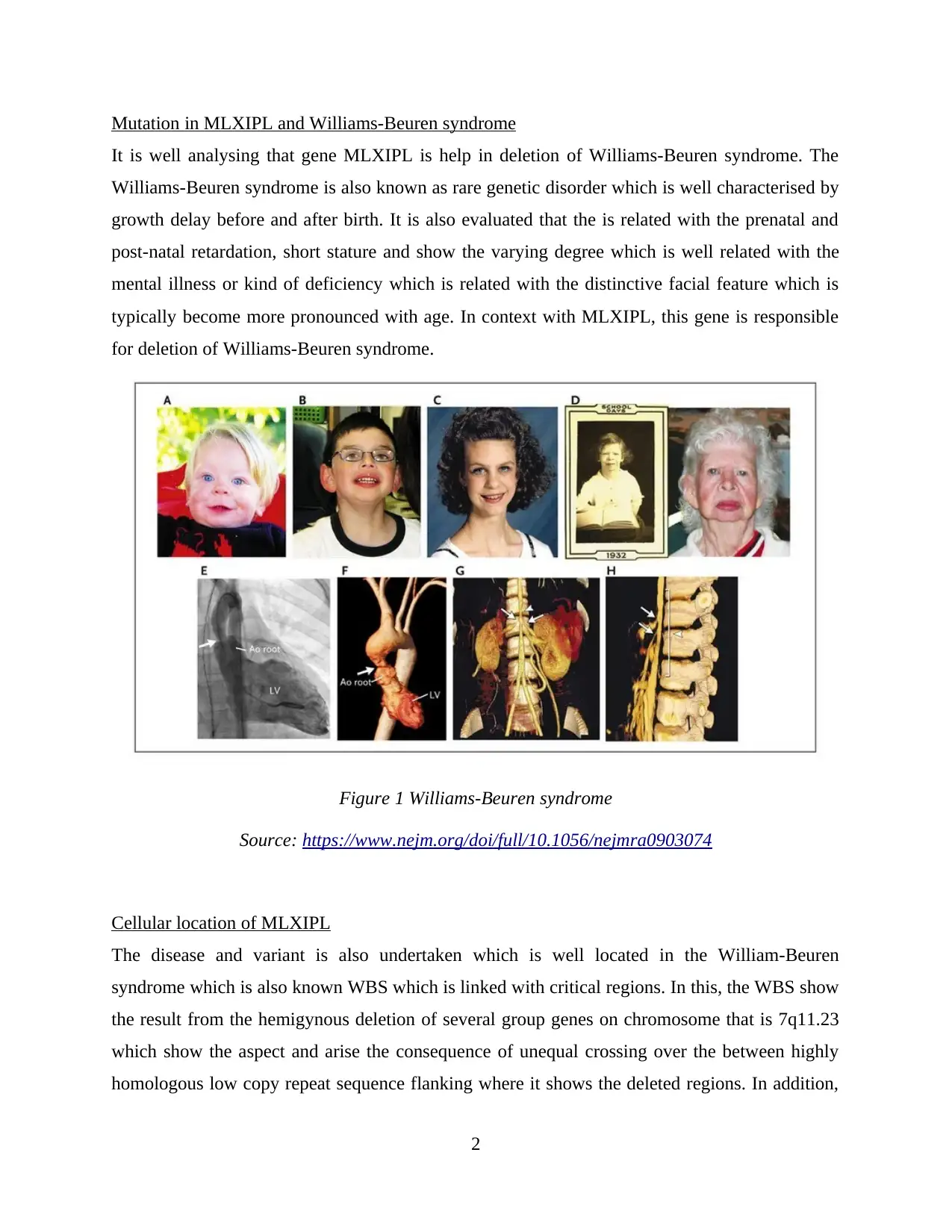
Mutation in MLXIPL and Williams-Beuren syndrome
It is well analysing that gene MLXIPL is help in deletion of Williams-Beuren syndrome. The
Williams-Beuren syndrome is also known as rare genetic disorder which is well characterised by
growth delay before and after birth. It is also evaluated that the is related with the prenatal and
post-natal retardation, short stature and show the varying degree which is well related with the
mental illness or kind of deficiency which is related with the distinctive facial feature which is
typically become more pronounced with age. In context with MLXIPL, this gene is responsible
for deletion of Williams-Beuren syndrome.
Figure 1 Williams-Beuren syndrome
Source: https://www.nejm.org/doi/full/10.1056/nejmra0903074
Cellular location of MLXIPL
The disease and variant is also undertaken which is well located in the William-Beuren
syndrome which is also known WBS which is linked with critical regions. In this, the WBS show
the result from the hemigynous deletion of several group genes on chromosome that is 7q11.23
which show the aspect and arise the consequence of unequal crossing over the between highly
homologous low copy repeat sequence flanking where it shows the deleted regions. In addition,
2
It is well analysing that gene MLXIPL is help in deletion of Williams-Beuren syndrome. The
Williams-Beuren syndrome is also known as rare genetic disorder which is well characterised by
growth delay before and after birth. It is also evaluated that the is related with the prenatal and
post-natal retardation, short stature and show the varying degree which is well related with the
mental illness or kind of deficiency which is related with the distinctive facial feature which is
typically become more pronounced with age. In context with MLXIPL, this gene is responsible
for deletion of Williams-Beuren syndrome.
Figure 1 Williams-Beuren syndrome
Source: https://www.nejm.org/doi/full/10.1056/nejmra0903074
Cellular location of MLXIPL
The disease and variant is also undertaken which is well located in the William-Beuren
syndrome which is also known WBS which is linked with critical regions. In this, the WBS show
the result from the hemigynous deletion of several group genes on chromosome that is 7q11.23
which show the aspect and arise the consequence of unequal crossing over the between highly
homologous low copy repeat sequence flanking where it shows the deleted regions. In addition,
2
Paraphrase This Document
Need a fresh take? Get an instant paraphrase of this document with our AI Paraphraser
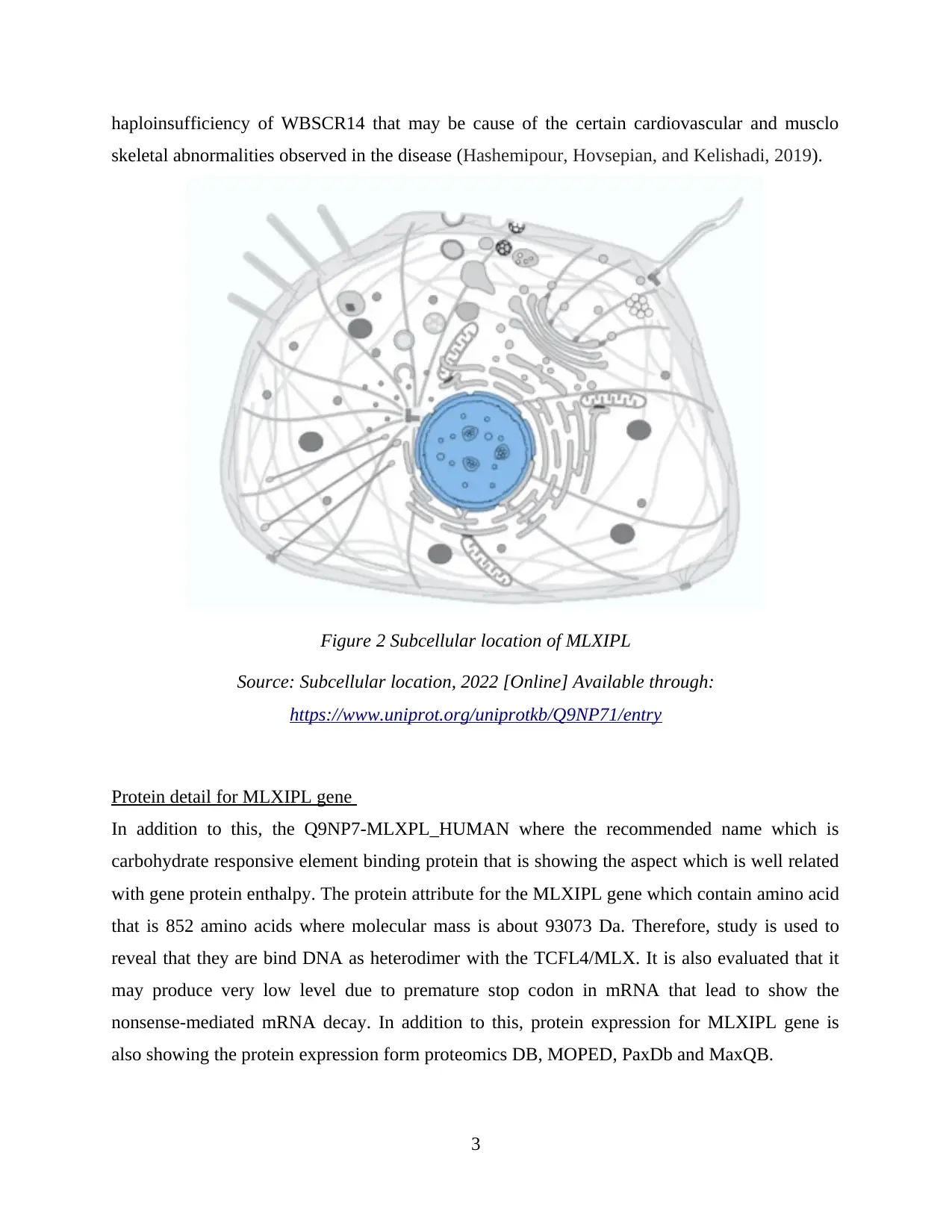
haploinsufficiency of WBSCR14 that may be cause of the certain cardiovascular and musclo
skeletal abnormalities observed in the disease (Hashemipour, Hovsepian, and Kelishadi, 2019).
Figure 2 Subcellular location of MLXIPL
Source: Subcellular location, 2022 [Online] Available through:
https://www.uniprot.org/uniprotkb/Q9NP71/entry
Protein detail for MLXIPL gene
In addition to this, the Q9NP7-MLXPL_HUMAN where the recommended name which is
carbohydrate responsive element binding protein that is showing the aspect which is well related
with gene protein enthalpy. The protein attribute for the MLXIPL gene which contain amino acid
that is 852 amino acids where molecular mass is about 93073 Da. Therefore, study is used to
reveal that they are bind DNA as heterodimer with the TCFL4/MLX. It is also evaluated that it
may produce very low level due to premature stop codon in mRNA that lead to show the
nonsense-mediated mRNA decay. In addition to this, protein expression for MLXIPL gene is
also showing the protein expression form proteomics DB, MOPED, PaxDb and MaxQB.
3
skeletal abnormalities observed in the disease (Hashemipour, Hovsepian, and Kelishadi, 2019).
Figure 2 Subcellular location of MLXIPL
Source: Subcellular location, 2022 [Online] Available through:
https://www.uniprot.org/uniprotkb/Q9NP71/entry
Protein detail for MLXIPL gene
In addition to this, the Q9NP7-MLXPL_HUMAN where the recommended name which is
carbohydrate responsive element binding protein that is showing the aspect which is well related
with gene protein enthalpy. The protein attribute for the MLXIPL gene which contain amino acid
that is 852 amino acids where molecular mass is about 93073 Da. Therefore, study is used to
reveal that they are bind DNA as heterodimer with the TCFL4/MLX. It is also evaluated that it
may produce very low level due to premature stop codon in mRNA that lead to show the
nonsense-mediated mRNA decay. In addition to this, protein expression for MLXIPL gene is
also showing the protein expression form proteomics DB, MOPED, PaxDb and MaxQB.
3
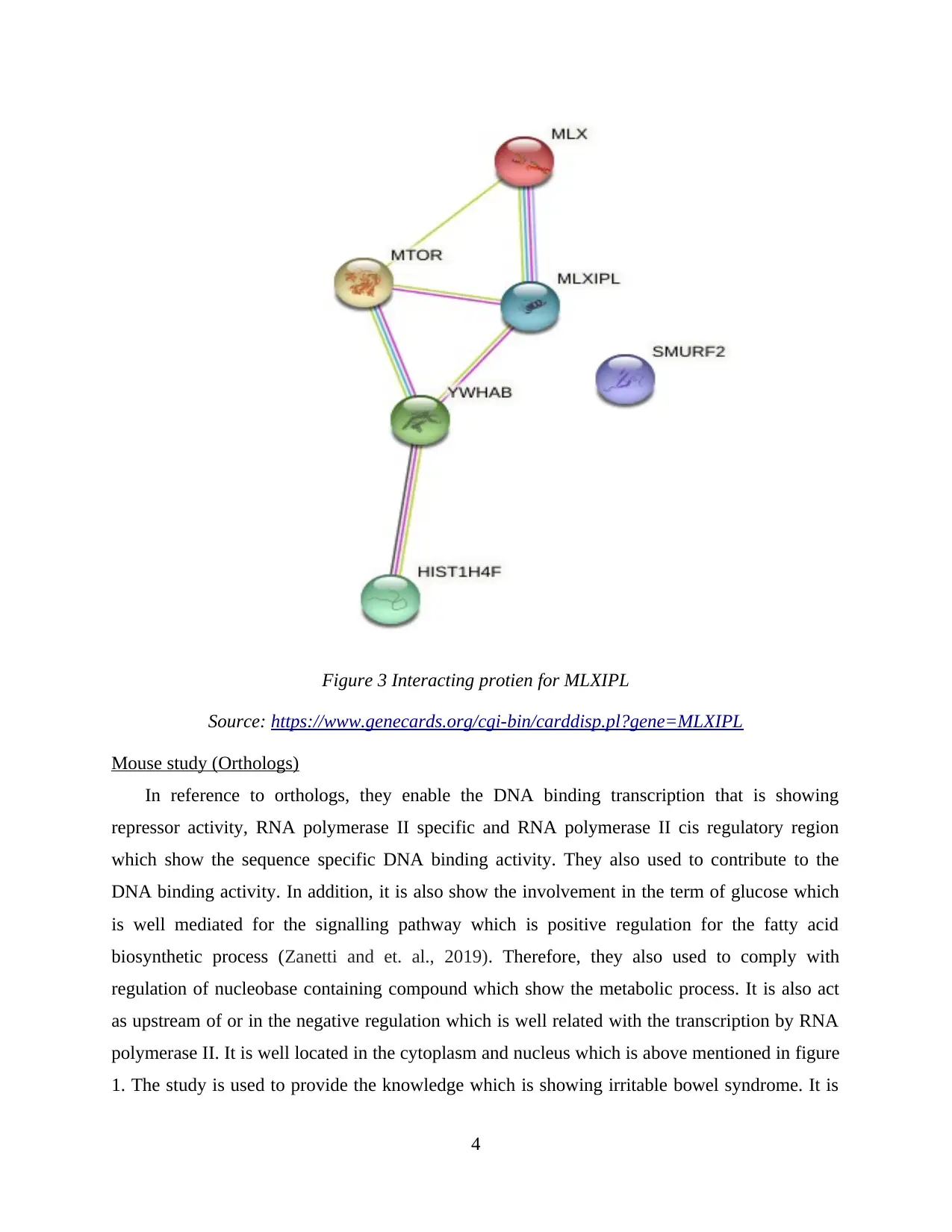
Figure 3 Interacting protien for MLXIPL
Source: https://www.genecards.org/cgi-bin/carddisp.pl?gene=MLXIPL
Mouse study (Orthologs)
In reference to orthologs, they enable the DNA binding transcription that is showing
repressor activity, RNA polymerase II specific and RNA polymerase II cis regulatory region
which show the sequence specific DNA binding activity. They also used to contribute to the
DNA binding activity. In addition, it is also show the involvement in the term of glucose which
is well mediated for the signalling pathway which is positive regulation for the fatty acid
biosynthetic process (Zanetti and et. al., 2019). Therefore, they also used to comply with
regulation of nucleobase containing compound which show the metabolic process. It is also act
as upstream of or in the negative regulation which is well related with the transcription by RNA
polymerase II. It is well located in the cytoplasm and nucleus which is above mentioned in figure
1. The study is used to provide the knowledge which is showing irritable bowel syndrome. It is
4
Source: https://www.genecards.org/cgi-bin/carddisp.pl?gene=MLXIPL
Mouse study (Orthologs)
In reference to orthologs, they enable the DNA binding transcription that is showing
repressor activity, RNA polymerase II specific and RNA polymerase II cis regulatory region
which show the sequence specific DNA binding activity. They also used to contribute to the
DNA binding activity. In addition, it is also show the involvement in the term of glucose which
is well mediated for the signalling pathway which is positive regulation for the fatty acid
biosynthetic process (Zanetti and et. al., 2019). Therefore, they also used to comply with
regulation of nucleobase containing compound which show the metabolic process. It is also act
as upstream of or in the negative regulation which is well related with the transcription by RNA
polymerase II. It is well located in the cytoplasm and nucleus which is above mentioned in figure
1. The study is used to provide the knowledge which is showing irritable bowel syndrome. It is
4
⊘ This is a preview!⊘
Do you want full access?
Subscribe today to unlock all pages.

Trusted by 1+ million students worldwide
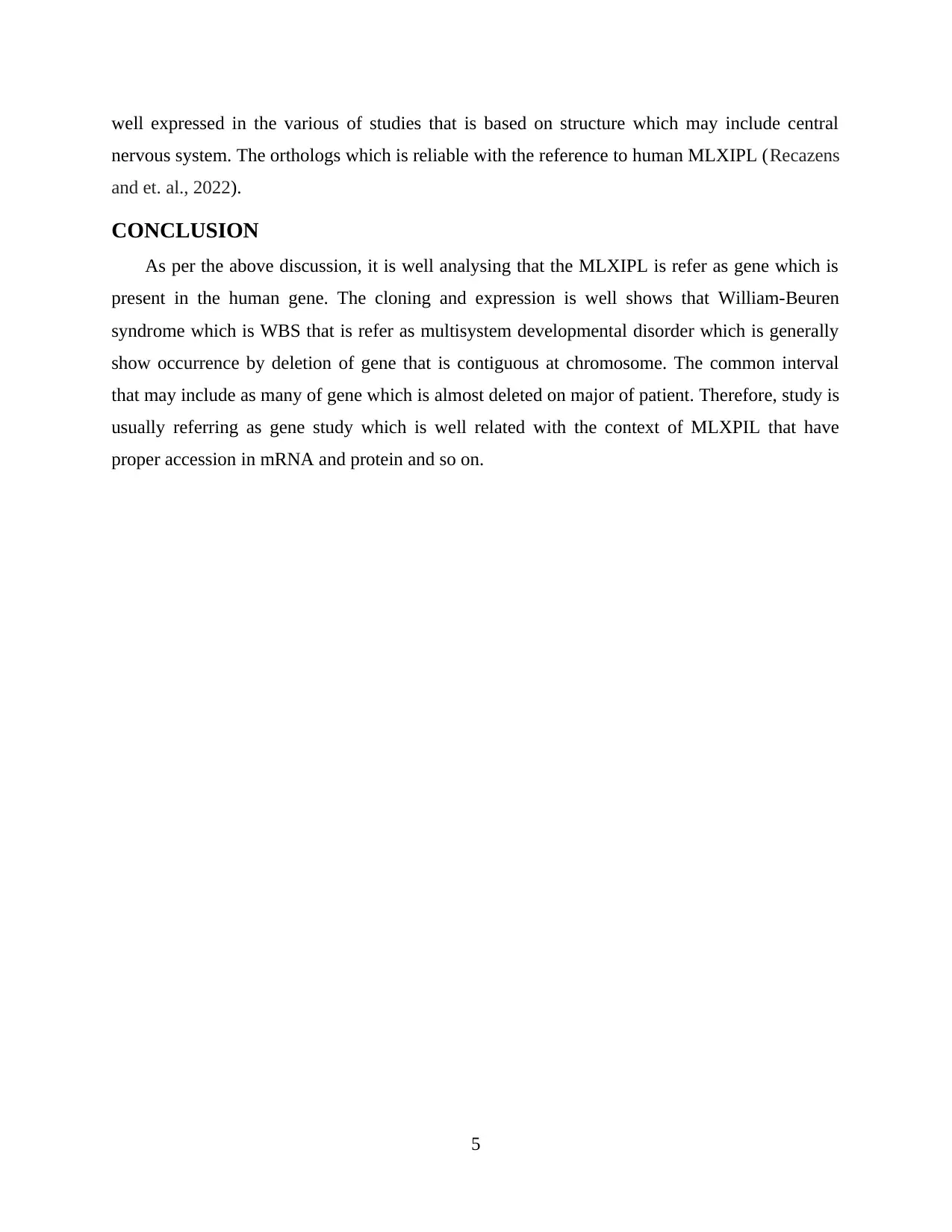
well expressed in the various of studies that is based on structure which may include central
nervous system. The orthologs which is reliable with the reference to human MLXIPL (Recazens
and et. al., 2022).
CONCLUSION
As per the above discussion, it is well analysing that the MLXIPL is refer as gene which is
present in the human gene. The cloning and expression is well shows that William-Beuren
syndrome which is WBS that is refer as multisystem developmental disorder which is generally
show occurrence by deletion of gene that is contiguous at chromosome. The common interval
that may include as many of gene which is almost deleted on major of patient. Therefore, study is
usually referring as gene study which is well related with the context of MLXPIL that have
proper accession in mRNA and protein and so on.
5
nervous system. The orthologs which is reliable with the reference to human MLXIPL (Recazens
and et. al., 2022).
CONCLUSION
As per the above discussion, it is well analysing that the MLXIPL is refer as gene which is
present in the human gene. The cloning and expression is well shows that William-Beuren
syndrome which is WBS that is refer as multisystem developmental disorder which is generally
show occurrence by deletion of gene that is contiguous at chromosome. The common interval
that may include as many of gene which is almost deleted on major of patient. Therefore, study is
usually referring as gene study which is well related with the context of MLXPIL that have
proper accession in mRNA and protein and so on.
5
Paraphrase This Document
Need a fresh take? Get an instant paraphrase of this document with our AI Paraphraser
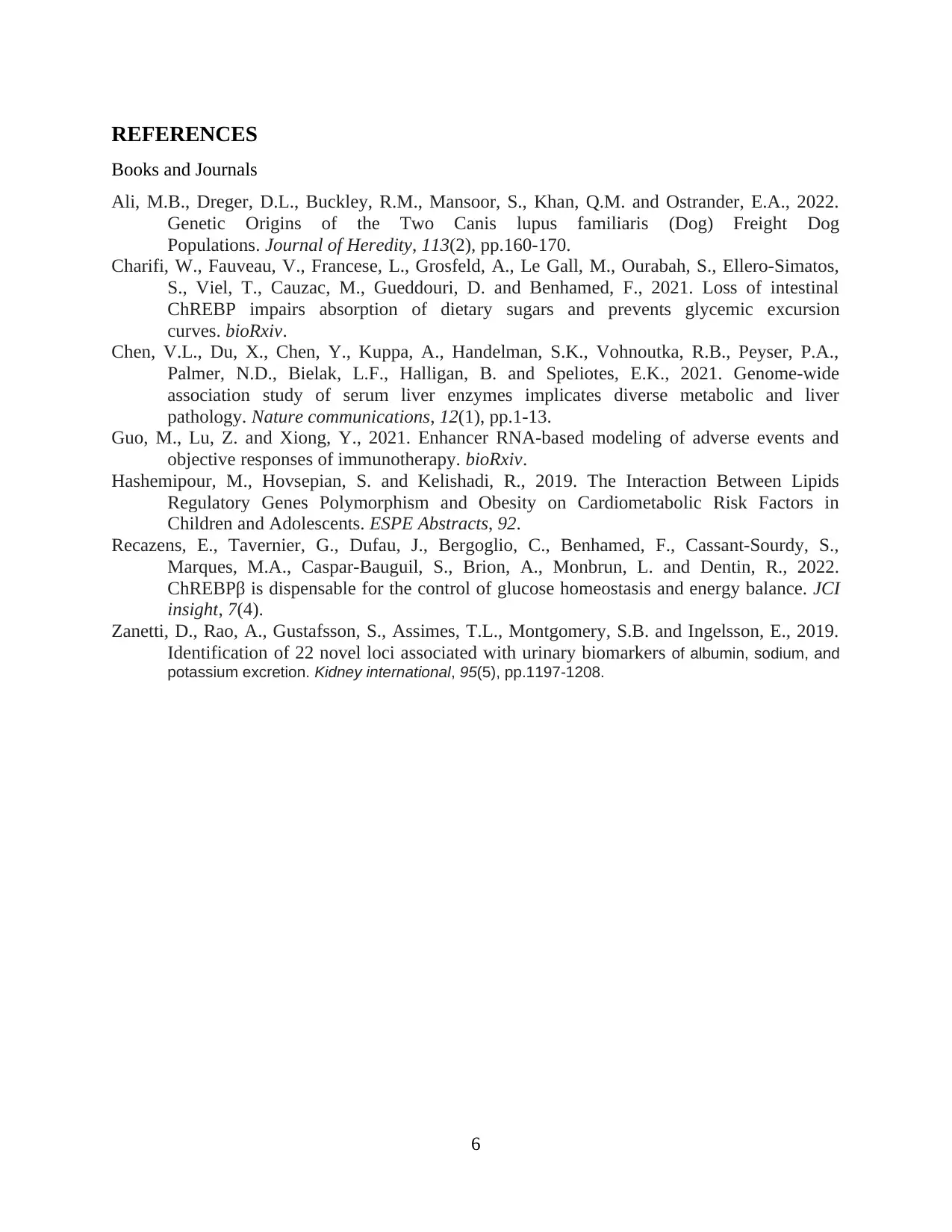
REFERENCES
Books and Journals
Ali, M.B., Dreger, D.L., Buckley, R.M., Mansoor, S., Khan, Q.M. and Ostrander, E.A., 2022.
Genetic Origins of the Two Canis lupus familiaris (Dog) Freight Dog
Populations. Journal of Heredity, 113(2), pp.160-170.
Charifi, W., Fauveau, V., Francese, L., Grosfeld, A., Le Gall, M., Ourabah, S., Ellero-Simatos,
S., Viel, T., Cauzac, M., Gueddouri, D. and Benhamed, F., 2021. Loss of intestinal
ChREBP impairs absorption of dietary sugars and prevents glycemic excursion
curves. bioRxiv.
Chen, V.L., Du, X., Chen, Y., Kuppa, A., Handelman, S.K., Vohnoutka, R.B., Peyser, P.A.,
Palmer, N.D., Bielak, L.F., Halligan, B. and Speliotes, E.K., 2021. Genome-wide
association study of serum liver enzymes implicates diverse metabolic and liver
pathology. Nature communications, 12(1), pp.1-13.
Guo, M., Lu, Z. and Xiong, Y., 2021. Enhancer RNA-based modeling of adverse events and
objective responses of immunotherapy. bioRxiv.
Hashemipour, M., Hovsepian, S. and Kelishadi, R., 2019. The Interaction Between Lipids
Regulatory Genes Polymorphism and Obesity on Cardiometabolic Risk Factors in
Children and Adolescents. ESPE Abstracts, 92.
Recazens, E., Tavernier, G., Dufau, J., Bergoglio, C., Benhamed, F., Cassant-Sourdy, S.,
Marques, M.A., Caspar-Bauguil, S., Brion, A., Monbrun, L. and Dentin, R., 2022.
ChREBPβ is dispensable for the control of glucose homeostasis and energy balance. JCI
insight, 7(4).
Zanetti, D., Rao, A., Gustafsson, S., Assimes, T.L., Montgomery, S.B. and Ingelsson, E., 2019.
Identification of 22 novel loci associated with urinary biomarkers of albumin, sodium, and
potassium excretion. Kidney international, 95(5), pp.1197-1208.
6
Books and Journals
Ali, M.B., Dreger, D.L., Buckley, R.M., Mansoor, S., Khan, Q.M. and Ostrander, E.A., 2022.
Genetic Origins of the Two Canis lupus familiaris (Dog) Freight Dog
Populations. Journal of Heredity, 113(2), pp.160-170.
Charifi, W., Fauveau, V., Francese, L., Grosfeld, A., Le Gall, M., Ourabah, S., Ellero-Simatos,
S., Viel, T., Cauzac, M., Gueddouri, D. and Benhamed, F., 2021. Loss of intestinal
ChREBP impairs absorption of dietary sugars and prevents glycemic excursion
curves. bioRxiv.
Chen, V.L., Du, X., Chen, Y., Kuppa, A., Handelman, S.K., Vohnoutka, R.B., Peyser, P.A.,
Palmer, N.D., Bielak, L.F., Halligan, B. and Speliotes, E.K., 2021. Genome-wide
association study of serum liver enzymes implicates diverse metabolic and liver
pathology. Nature communications, 12(1), pp.1-13.
Guo, M., Lu, Z. and Xiong, Y., 2021. Enhancer RNA-based modeling of adverse events and
objective responses of immunotherapy. bioRxiv.
Hashemipour, M., Hovsepian, S. and Kelishadi, R., 2019. The Interaction Between Lipids
Regulatory Genes Polymorphism and Obesity on Cardiometabolic Risk Factors in
Children and Adolescents. ESPE Abstracts, 92.
Recazens, E., Tavernier, G., Dufau, J., Bergoglio, C., Benhamed, F., Cassant-Sourdy, S.,
Marques, M.A., Caspar-Bauguil, S., Brion, A., Monbrun, L. and Dentin, R., 2022.
ChREBPβ is dispensable for the control of glucose homeostasis and energy balance. JCI
insight, 7(4).
Zanetti, D., Rao, A., Gustafsson, S., Assimes, T.L., Montgomery, S.B. and Ingelsson, E., 2019.
Identification of 22 novel loci associated with urinary biomarkers of albumin, sodium, and
potassium excretion. Kidney international, 95(5), pp.1197-1208.
6

7
⊘ This is a preview!⊘
Do you want full access?
Subscribe today to unlock all pages.

Trusted by 1+ million students worldwide
1 out of 9
Related Documents
Your All-in-One AI-Powered Toolkit for Academic Success.
+13062052269
info@desklib.com
Available 24*7 on WhatsApp / Email
![[object Object]](/_next/static/media/star-bottom.7253800d.svg)
Unlock your academic potential
Copyright © 2020–2025 A2Z Services. All Rights Reserved. Developed and managed by ZUCOL.





